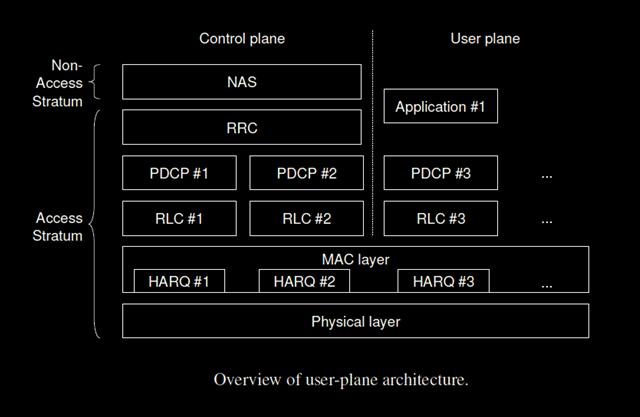LTE Layer 2 user plane protocol stack in detail
LTE user Layer 2 Protocol stack-the plan is composed of three substrates, as shown in the figure.
- Packet layer packet data convergence Protocol (PDCP) : this layer processes messages resource control (RRC) in the control plan and packages of Internet Protocol (IP) addresses in the user’s plan. According to the spokesman, the main functions of the PDCP are header compression, security (encryption and integrity protection) and support for reordering and retransmission during teaching. For radio bearers which are configured to use the PDCP, there is only one entity per PDCP radio spokesman.
- The Radio Link Control (RLC) : the main functions of the layer are segmentation and reassembly of RLC top layer of packages in order to adapt them to the size that can be effectively transmitted over the radio interface. For radio bearers which are in need of transmission errors, the RLC is relayed to discover how to recover from packet losses. In addition, the RLC Reordering performed to compensate for out-of-order Receipt due to hybrid automatic repeat request (HARQ) Layer below. There is only one entity per RLC radio spokesman.
- Medium-MAC (Access Control) layer: This layer performs the multiplexing of data for a variety of radio carriers. Therefore, it is not only one of the MAC for the UE. Determining the amount of data that can be transmitted from each radio bearer layer, the size of the packet, RLC and instructing on the MAC layer to achieve negotiated Quality of Service (QoS) for each radio bearer. Uplink, this process involves communication of the amount of data to transfer the eNodeB.

On the sending side, each layer receives a data service unit (SDU) from the higher layers, layer provides services and outputs the Protocol data unit (PDU) to the lower layer. A layer of RLC receives packets from PDCP layers. These packages are called PDUs with the PDCP point of view, and represent the PDCP RLC SDUs perspective, RLC. A layer of RLC creates packages that are scheduled for the layer below, i.e., the MAC layer.
Packets are the RLC RLC MAC layer PDUs from the RLC SDUs and MAC MAC perspective. On the receiving side, facing the process, with each layer by layer to the SDUs above, if they are received as PDUs.
An important feature of the LTE protocol stack is that all PDUs and SDUs byte aligned. This is To facilitate handling of microprocessors, which are usually defined to handle packages in units of bytes. To further reduce the processing requirements of the user plane Protocol Fund in LTE, the head, who created each of the PDCP, RLC and MAC layer are also byte-aligned. This means that sometimes the unused padding bits are needed in the minds, and thus the cost of design for effective treatment is that it is spent small amounts of potentially available capacity.